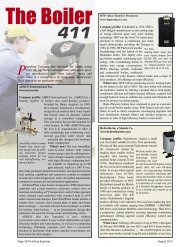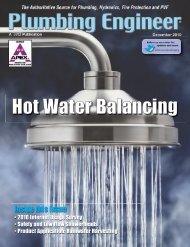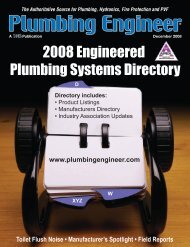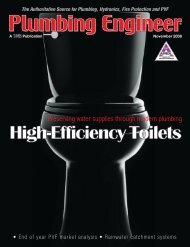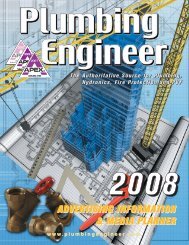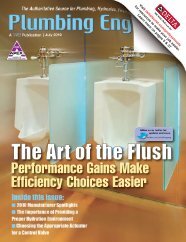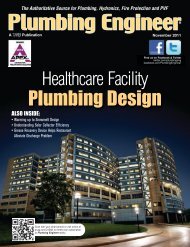open issue - Plumbing Engineer
open issue - Plumbing Engineer
open issue - Plumbing Engineer
Create successful ePaper yourself
Turn your PDF publications into a flip-book with our unique Google optimized e-Paper software.
Letters to the Editor<br />
Onsite wastewater treatment<br />
Ron George,<br />
We are designing an onsite wastewater treatment system<br />
for a small stadium. What are the recommended flow<br />
rates…<br />
• Per seat<br />
• Per player<br />
• Per employee<br />
...so that we may adequately size the system?<br />
Any other related information and sources of information<br />
would be appreciated.<br />
Thanks for your continued assistance.<br />
Ramdeo Maraj CPD<br />
Ramdeo,<br />
I am not sure what kind of stadium you are designing<br />
this for, but here are a few thoughts to maybe help you out.<br />
As far as wastewater pumping goes, most of the stadiums<br />
I have designed were connected to the public sewer<br />
by gravity. Consider the old adage, “What goes in must<br />
come out.” Waste flow rates tend to spread out over time,<br />
as the flow rate for a flush is between 25 to 35 gpm at a<br />
flush valve during the few seconds of a flush; a few hundred<br />
feet down the drain line the few seconds of flow can<br />
be spread out into about a minute of flow. But for pumping<br />
you should use the “goes into” and “goes out of” theory,<br />
or gozinta, gozouta.<br />
I do forensic investigations of building failures. One of<br />
my investigations involved a stadium that had an existing<br />
sewer main located nearby that was significantly undersized.<br />
The nearest sewer large enough to handle the stadium<br />
effluent was more than a mile away in a major urban<br />
area. The cost of upgrading the public sewer was very<br />
high, and the decision was made to use a large holding<br />
tank to receive the waste effluent from the stadium during<br />
a typical two to three hour football game and pump it out<br />
at a lower flow rate that the sewers could handle. A concrete<br />
holding tank of approximately 750,000 gallons was<br />
constructed under the lower concourse. The waste flowed<br />
into this tank; duplex sewage pumps pumped the waste out<br />
of the tank and into the public sewer at about 800 gallons<br />
per minute.<br />
The problem was that the use of the stadium changed<br />
beyond the design parameters. A concert promoter leased<br />
it for an all day concert that began at 11 a.m. and went<br />
until after midnight. The sewage tanks were only designed<br />
to hold sewage for from three to four hours of peak flow,<br />
with the pumps discharging through a sewage line one<br />
pipe size smaller than the public sewer. After a few hours,<br />
the tank filled up, sewage backed up into all the fixtures on<br />
the lower level and, as people on the upper concourses<br />
flushed, there was no place for the waste to go but out of<br />
the fixtures on the lower levels. The sewage ran down the<br />
concourses and the ramps to the field and started to fill<br />
the stadium bowl with three to four inches of sewage. As<br />
you can imagine, there were lots of lawsuits and millions<br />
in damages for repairs, replacements costs and loss of use<br />
of the facility.<br />
In this case there was a control panel that turned on the<br />
lag pump and another level switch that turned on a high<br />
water alarm light on the panel, but it was not remotely<br />
monitored and it was not set to automatically shut off the<br />
building water supply when the sewage tanks were full.<br />
Something to think about if this is a possibility in your<br />
case. On a couple of recent stadium projects, I designed<br />
the plumbing, which again was connected to the public<br />
sewer by gravity. Using the “goes into” and “goes out of”<br />
theory, you can approximate the waste flows. The design<br />
included the booster pump packages for a 65,000 seat stadium<br />
for an NFL football team and a 45,000 seat major<br />
league baseball stadium. We had a quadraplex (four)<br />
booster pump package with four 900 gpm pumps. The<br />
pumps had controls to alternate the pumps for even wear.<br />
A hydro-pneumatic tank located on the opposite side of the<br />
stadium on the upper level concourse allowed for pump<br />
shutdown during periods of non-use. Each pump was<br />
sized for 900 gpm, for a total booster pump package flow<br />
rate of 3,600 gpm.<br />
The football stadium had a 24-inch suction main to<br />
serve the domestic water and fire pumps with a 14-inch<br />
discharge cold water main to a loop in the lower concourse,<br />
which was a 12-inch diameter, schedule 10 stainless<br />
steel inch pipe with three-inch, two-inch and 1 ½-inch<br />
branch connections to restrooms and concessions. The<br />
branches were welded on the water mains with stainless<br />
steel nipples with grooved connections on the other end to<br />
accept a shut-off valve and dielectric connections to copper<br />
pipe for the three-inch and smaller pipes. In this particular<br />
project, there was an adjacent high rise building<br />
with other multi-use functions that had a separate booster<br />
pump sized with the flow required for that area with a<br />
higher head pressure for that building in order to have<br />
adequate pressure at the top of the building.<br />
I am not sure what type of stadium you are working on,<br />
but this should put you in the ballpark for a football or<br />
soccer stadium. Baseball stadiums should use about 0.06<br />
gpm per seat, because many stadiums can be used for concerts<br />
or other events that might have higher peak<br />
demands.<br />
The green solution is to consider the use of a hydropneumatic<br />
tank to allow no-flow shutdown and to consider<br />
variable speed pumping if the stadium will be used a<br />
lot. If the stadium will sit for long periods unused, consider<br />
just using constant speed pumps with pressure or current<br />
sensing controls to turn on additional pumps as<br />
demand increases.<br />
Ron<br />
Sprinklers in elevator machine rooms<br />
and hoistways<br />
Sam Dannaway,<br />
I have been a loyal reader of <strong>Plumbing</strong> <strong>Engineer</strong> magazine,<br />
including the FPE Corner. I read your article in the<br />
Feb. 2012 <strong>issue</strong> with reference to sprinklers in elevator<br />
machine rooms and hoistways. My experience is that<br />
Page 66/<strong>Plumbing</strong> <strong>Engineer</strong> April 2012




